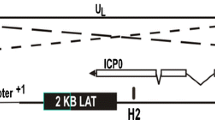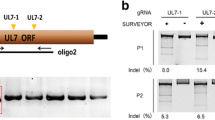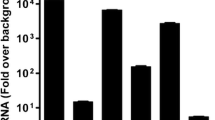Abstract
Monkey B virus (Macacine herpesvirus 1; BV) is noted for its extreme neurovirulence in humans. Since the vhs protein encoded by the UL41 gene has been shown to be a neurovirulence factor in the related human herpes simplex viruses, the role of the UL41 gene in BV neurovirulence was investigated. BV mutants were constructed that lacked the entire UL41 ORF (Δ41) or had the RNase active site mutated (Δ41A). Neither mutant shut off host protein synthesis, degraded β-actin mRNA, or prevented an IFN-β response, indicating that the vhs protein and its RNase activity are both necessary for these activities. Replication of both mutants in primary mouse cells was impaired and they exhibited a prolonged disease course in mice. Whereas Δ41 infected mice were euthanized for symptoms related to central nervous system (CNS) infection, Δ41A infected mice were euthanized primarily for symptoms of autonomic nervous system dysfunction. While neuroinvasiveness was not affected, lesions in the CNS were more limited in size, anatomical distribution, and severity than for wild-type virus. These results indicate that the vhs protein affects the general replicative efficiency of BV in vivo rather than being a specific neurovirulence factor critical for invasion of or preferential replication in the CNS.
Similar content being viewed by others
References
Barzilai A, Zivony-Elbom I, Sarid R, Noah E, Frenkel N, 2006. The herpes simplex virus type 1 vhs-UL41 gene secures viral replication by temporarily evading apoptotic cellular response to infection: Vhs-UL41 activity might require interactions with elements of cellular mRNA degradation machinery. J Virol, 80: 505–513.
Black D H, Saliki J T, Eberle R. 2002. Development of a green fluorescent protein reporter cell line to reduce biohazards associated with detection of infectious Cercopithecine herpesvirus 1 (monkey B virus) in clinical specimens. Compar Med, 52:534–542.
Chou J, Kern E R, Whitley R J, Roizman B. 1990. Mapping of herpes simplex virus-1 neurovirulence to gamma 134.5, a gene nonessential for growth in culture. Science, 250: 1262–1266.
Dauber B, Pelletier J, Smiley J R. 2011. The herpes simplex virus 1 vhs protein enhances translation of viral true late mRNAs and virus production in a cell type-dependent manner. J Virol, 85:5363–5373.
Duerst R J, Morrison L A. 2004. Herpes simplex virus 2 virion host shutoff protein interferes with type I interferon production and responsiveness. Virology, 322:158–167.
Elmore D, Eberle R. 2008. Monkey B virus (Cercopithecine herpesvirus 1). Compar Med, 58:11–21.
Esclatine A, Taddeo B, Evans L, Roizman B. 2004a. The herpes simplex virus 1 UL41 gene-dependent destabilization of cellular RNAs is selective and may be sequence-specific. Proc Natl Acad Sci U S A, 101:3603–3608.
Esclatine A, Taddeo B, Roizman B. 2004b. The UL41 protein of herpes simplex virus mediates selective stabilization or degradation of cellular mRNAs. Proc Natl Acad Sci U S A, 101:18165–18170.
Everly D N, Feng P, Mian I S, Read G S. 2002. mRNA degradation by the virion host shutoff (vhs) protein of herpes simplex virus: genetic and biochemical evidence that vhs is a nuclease. J Virol, 76:8560–8571.
Feng P, Everly D N, Jr., Read G S. 2005. mRNA decay during herpes simplex virus (HSV) infections: protein-protein interactions involving the HSV virion host shutoff protein and translation factors eIF4H and eIF4A. J Virol, 79, 9651–9664.
Hilliard J K, Eberle R, Lipper S L, Munoz R M, Weiss S A. 1987. Herpesvirus simiae (B virus): replication of the virus and identification of viral polypeptides in infected cells. Arch Virol, 93:185–198.
Huff J L, Barry P A. 2003. B-virus (Cercopithecine herpesvirus 1) infection in humans and macaques: potential for zoonotic disease. Emer Infect Dis, 9, 246–250.
Hull R N, 1971. B virus vaccine. Lab Anim Sci, 21:1068–1071.
Jing X, Cerveny M, Yang K, He B. 2004. Replication of herpes simplex virus 1 depends on the gamma 134.5 functions that facilitate virus response to interferon and egress in the different stages of productive infection. J Virol, 78:7653–7666.
Karr B M, Read G S. 1999. The virion host shutoff function of herpes simplex virus degrades the 5′ end of a target mRNA before the 3′ end. Virology, 264:195–204.
Korom M, Wylie K M, Morrison L A. 2008. Selective ablation of virion host shutoff protein RNase activity attenuates herpes simplex virus 2 in mice. J Virol, 82:3642–3653.
Lundberg P, Ramakrishna C, Brown J, Tyszka J M, Hamamura M, Hinton D R, Kovats S, Nalcioglu O, Weinberg K, Openshaw H, Cantin E M. 2008. The immune response to herpes simplex virus type 1 infection in susceptible mice is a major cause of central nervous system pathology resulting in fatal encephalitis. J Virol, 82:7078–7088.
MacLean A R, ul-Fareed M, Robertson L, Harland J, Brown S M. 1991. Herpes simplex virus type 1 deletion variants 1714 and 1716 pinpoint neurovirulence-related sequences in Glasgow strain 17+ between immediate early gene 1 and the ‘a’ sequence. J Gen Virol, 72(Pt 3):631–639.
Mossman K L, Ashkar A A. 2005. Herpesviruses and the innate immune response. Viral Immunol, 18: 267–281.
Ohsawa K, Black D, Ohsawa M, Eberle R. 2014. Genome sequence of a pathogenic isolate of monkey B virus (species Macacine herpesvirus 1). Arch Virol, 159(10):2819–2821.
Page H G, Read G S. 2010. The virion host shutoff endonuclease (UL41) of herpes simplex virus interacts with the cellular capbinding complex eIF4F. J Virol, 84:6886–6890.
Pasieka T J, Lu B, Crosby S D, Wylie K M, Morrison L A, Alexander D E, Menachery V D, Leib D A. 2008. Herpes simplex virus virion host shutoff attenuates establishment of the antiviral state. J Virol, 82:5527–5535.
Paul S, Ricour C, Sommereyns C, Sorgeloos F, Michiels T. 2007. Type I interferon response in the central nervous system. Biochimie, 89:770–778.
Perelygina L, Zhu L, Zurkuhlen H, Mills R, Borodovsky M, Hilliard J K. 2003. Complete sequence and comparative analysis of the genome of herpes B virus (Cercopithecine herpesvirus 1) from a rhesus monkey. J Virol, 77:6167–6177.
Ritchey J W, Ealey K A, Payton M, Eberle R. 2002. Comparative pathology of infections with baboon and African green monkey alpha-herpesviruses in mice. J Compar Pathol, 127:150–161.
Rogers K M, Black D H, Eberle R. 2007. Primary mouse dermal fibroblast cell cultures as an in vitro model system for the differential pathogenicity of cross-species herpesvirus papio 2 infections. Arch Virol, 152: 543–552.
Rogers K M, Deatheridge M, Breshears M A, Chapman S, Black D, Ritchey J W, Payton M, Eberle R. 2009. Type I IFN response to Papiine herpesvirus 2 (Herpesvirus papio 2; HVP2) determines neuropathogenicity in mice. Virology, 386:280–289.
Rogers K M, Ritchey J W, Payton M, Black D H, Eberle R. 2006. Neuropathogenesis of Herpesvirus papio 2 in Mice Parallels Cercopithecine herpesvirus 1 (B Virus) Infections in Humans. J Gen Virol, 87:267–276.
Saffran H A, Read G S, Smiley J R. 2010. Evidence for translational regulation by the herpes simplex virus virion host shutoff protein. J Virol, 84:6041–6049.
Shu M, Taddeo B, Zhang W, Roizman B. 2013. Selective degradation of mRNAs by the HSV host shutoff RNase is regulated by the UL47 tegument protein. Proc Natl Acad Sci U S A, 110: E1669–E1675.
Simon M A, Daniel M D, Lee-Parritz D, King N W, Ringler D J. 1993. Disseminated B virus infection in a cynomolgus monkey. Lab Anim Sci, 43:545–550.
Smibert C A, Popova B, Xiao P, Capone J P, Smiley J R. 1994. Herpes simplex virus VP16 forms a complex with the virion host shutoff protein vhs. J Virol, 68:2339–2346.
Smiley J R, Elgadi M M, Saffran H A. 2001. Herpes simplex virus vhs protein. Meth Enzymol, 342:440–451.
Smith T J, Morrison L A, Leib D A. 2002. Pathogenesis of herpes simplex virus type 2 virion host shutoff (vhs) mutants. J Virol, 76:2054–2061.
Strelow L I, Leib D A. 1995. Role of the viron host shutoff (vhs) of herpes simplex virus type 1 in latency and pathogenesis. J Virol, 69:6779–6786.
Suzutani T, Nagamine M, Shibaki T, Ogasawara M, Yoshida I, Daikoku T, Nishiyama Y, Azuma M. 2000. The role of the UL41 gene of herpes simplex virus type 1 in evasion of non-specific host defence mechanisms during primary infection. J Gen Virol, 81:1763–1771.
Taddeo B, Sciortino M T, Zhang W, Roizman B. 2007. Interaction of herpes simplex virus RNase with VP16 and VP22 is required for the accumulation of the protein but not for accumulation of mRNA. Proc Natl Acad Sci U S A, 104:12163–12168.
Taddeo B, Zhang W, Roizman B. 2006. The U(L)41 protein of herpes simplex virus 1 degrades RNA by endonucleolytic cleavage in absence of other cellular or viral proteins. Proc Natl Acad Sci U S A, 103: 2827–2832.
Taddeo B, Zhang W, Roizman B. 2013. The herpes simplex virus host shutoff RNase degrades cellular and viral mRNAs made before infection but not viral mRNA made after infection. J Virol, 87:4516–4522.
Takeuchi O, Akira S. 2007. Recognition of viruses by innate immunity. Immunol Rev, 220:214–224.
Zelus B D, Stewart R S, Ross J. 1996. The virion host shutoff protein of herpes simplex virus type 1: messenger ribonucleolytic activity in vitro. J Virol, 70:2411–2419.
Author information
Authors and Affiliations
Corresponding author
Rights and permissions
About this article
Cite this article
Black, D., Ritchey, J., Payton, M. et al. Role of the virion host shutoff protein in neurovirulence of monkey B virus (Macacine herpesvirus 1). Virol. Sin. 29, 274–283 (2014). https://doi.org/10.1007/s12250-014-3495-x
Received:
Accepted:
Published:
Issue Date:
DOI: https://doi.org/10.1007/s12250-014-3495-x




